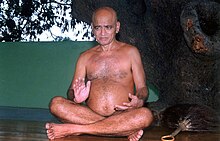Digambara
A Digambara ( Sanskrit , m., दिगम्बर, digambara, translated: "in the air", "in the sky dress" or "clothed in the world") is a member of a predominantly monk religious group belonging to Jainism .
way of life

Members of the Digambara sect interpret the commandments of Jainism more strictly than the Shvetambaras , who are also devout Jainas. Digambaras, however, are stricter ascetics and advocates of the unrestricted right to exist of every living being. They therefore practice non-violence ( ahimsa ) very consistently and try to avoid accidentally killing or injuring other living beings, including insects. This happens through immobility, wearing a face mask and / or carrying fronds with which - before stepping on - the floor is swept.
Digambaras do not take part in professional or economic life and reject material possessions. They live partially or completely naked; hence the name Digambara - "air-clad".
In the center of the Shravanabelagola sanctuary near Mysore , the Jain ascetic Bahubali / Gomateshvara, completely undressed according to Digambara custom, is depicted - the ideal image of many Jainas. His motionless meditation even goes so far that tendrils wind up on his body.
See also
literature
- Walther Schubring : Words of Mahavira. Critical translation from the Jain canon. Vandenhoeck & Ruprecht, Göttingen 1926. (Ed. Religious History Commission at the Society of Science in Göttingen, Sources of Religious History Group 7, Volume 14)
- Heinrich Zimmer : Philosophy and Religion of India. Suhrkamp, Frankfurt am Main 1973, ISBN 3-518-27626-3 .
- Helmuth von Glasenapp : Jainism. An Indian religion of salvation. Olms, Hildesheim 1984, ISBN 3-487-00628-6 (Suhrkamp Taschenbuch, Wissenschaft; 26).
- Franz Bätz: Holy mountains, temple cities and ascetics. Jainism - a living culture of India. Weishaupt, Wolfsberg 1997, ISBN 3-7059-0049-8 .
- Adelheid Mette : The Jaina's doctrine of redemption: legends, parables, stories. Verlag der Welteligionen, Berlin 2010, ISBN 978-3-458-70023-4 .
Web links
- Digambara - history etc. (Eng.)
